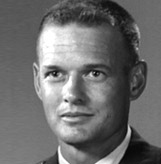
Robert Laurel Crippen is an American retired naval officer and aviator, test pilot, aerospace engineer, and retired astronaut. He traveled into space four times: as pilot of STS-1 in April 1981, the first Space Shuttle mission; and as commander of STS-7 in June 1983, STS-41-C in April 1984, and STS-41-G in October 1984. He was also a part of the Manned Orbiting Laboratory (MOL), Skylab Medical Experiment Altitude Test (SMEAT), ASTP support crew member, and the Approach and Landing Tests (ALT) for the Space Shuttle.

The Boeing X-20 Dyna-Soar was a United States Air Force (USAF) program to develop a spaceplane that could be used for a variety of military missions, including aerial reconnaissance, bombing, space rescue, satellite maintenance, and as a space interceptor to sabotage enemy satellites. The program ran from October 24, 1957, to December 10, 1963, cost US$660 million, and was cancelled just after spacecraft construction had begun.
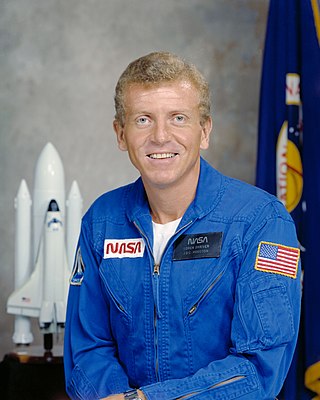
Loren James Shriver is a former NASA astronaut, aviator, and a retired US Air Force Colonel.
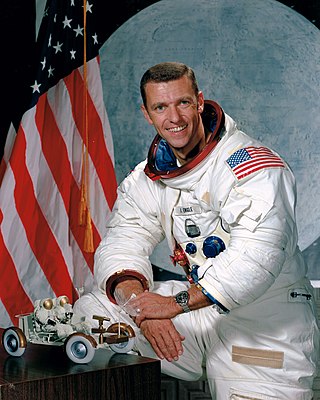
Joe Henry Engle is an American pilot, aeronautical engineer and former NASA astronaut. He was the commander of two Space Shuttle missions including STS-2 in 1981, the program's second orbital flight. He also flew two flights in the Shuttle program's 1977 Approach and Landing Tests. Engle is one of twelve pilots who flew the North American X-15, an experimental spaceplane jointly operated by the Air Force and NASA.

Charles Gordon Fullerton was a United States Air Force colonel, a USAF and NASA astronaut, and a research pilot at NASA's Dryden Flight Research Facility, Edwards, California. His assignments included a variety of flight research and support activities piloting NASA's B-52 launch aircraft, the Boeing 747 Shuttle Carrier Aircraft (SCA), and other multi-engine and high performance aircraft.

Colonel Robert Franklyn "Bob" Overmyer was an American test pilot, naval aviator, aeronautical engineer, physicist, United States Marine Corps officer, and USAF/NASA astronaut. Overmyer was selected by the Air Force as an astronaut for its Manned Orbiting Laboratory in 1966. Upon cancellation of the program in 1969, he became a NASA astronaut and served support crew duties for the Apollo program, Skylab program, and Apollo-Soyuz Test Project. In 1976, he was assigned to the Space Shuttle program and flew as pilot on STS-5 in 1982 and as commander on STS-51-B in 1985. He was selected as a lead investigator into the Space Shuttle Challenger disaster in 1986, retiring from NASA that same year. A decade later, Overmyer died while testing the Cirrus VK-30 homebuilt aircraft.

Donald Herod Peterson was a United States Air Force officer and NASA astronaut. Peterson was originally selected for the Air Force Manned Orbiting Laboratory (MOL) program, but, when that was canceled, he became a NASA astronaut in September 1969. He was a mission specialist on STS-6 on board Challenger. During the mission Peterson performed a spacewalk to test the new airlock and space suits. He logged 120 hours in space. Peterson retired from NASA in 1984.

Duane Gene "Digger" Carey is a retired lieutenant colonel in the United States Air Force and a former NASA astronaut. He piloted the space shuttle Columbia on March 1, 2002, during a Hubble Space Telescope servicing mission.

The Manned Orbiting Laboratory (MOL) was part of the United States Air Force (USAF) human spaceflight program in the 1960s. The project was developed from early USAF concepts of crewed space stations as reconnaissance satellites, and was a successor to the canceled Boeing X-20 Dyna-Soar military reconnaissance space plane. Plans for the MOL evolved into a single-use laboratory, for which crews would be launched on 30-day missions, and return to Earth using a Gemini B spacecraft derived from NASA's Gemini spacecraft and launched with the laboratory.

Steven Ray Nagel, , was an American astronaut, aeronautical and mechanical engineer, test pilot, and a United States Air Force pilot. In total, he logged 723 hours in space. After NASA, he worked at the University of Missouri College of Engineering as an instructor in its Mechanical and Aerospace Engineering Department.

The Mercury Seven were the group of seven astronauts selected to fly spacecraft for Project Mercury. They are also referred to as the Original Seven and Astronaut Group 1. Their names were publicly announced by NASA on April 9, 1959; these seven original American astronauts were Scott Carpenter, Gordon Cooper, John Glenn, Gus Grissom, Wally Schirra, Alan Shepard, and Deke Slayton. The Mercury Seven created a new profession in the United States, and established the image of the American astronaut for decades to come.

William Harvey Dana was an American aeronautical engineer, U.S. Air Force pilot, NASA test pilot, and astronaut. He was one of twelve pilots who flew the North American X-15, an experimental spaceplane jointly operated by the Air Force and NASA. He was also selected for participation in the X-20 Dyna-Soar program.

William John "Pete" Knight was an American aeronautical engineer, politician, Vietnam War combat pilot, test pilot, and astronaut. He was one of twelve pilots who flew the North American X-15, an experimental spaceplane jointly operated by the U.S. Air Force and NASA. He was also selected for participation in the X-20 Dyna-Soar program.
Henry Charles Gordon, , was an American aeronautical engineer, U.S. Air Force officer, test pilot, and astronaut in the X-20 Dyna-Soar program.
James Wayne Wood, , was an American aeronautical engineer, U.S. Air Force officer, test pilot, and astronaut in the X-20 Dyna-Soar program.

NASA Astronaut Group 7 was a group of seven astronauts accepted by the National Aeronautics and Space Administration (NASA) on August 14, 1969. It was the last group to be selected during the Project Apollo era, and the first since the Mercury Seven in which all members were active-duty military personnel, and all made flights into space.
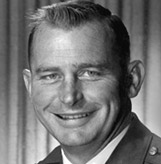
Richard Earl "Dick" Lawyer was a USAF astronaut, test pilot, and combat veteran. Although he trained for the USAF Manned Orbital Laboratory (MOL), the program was cancelled before any of the MOL crews reached space.

Lachlan "Mac" Macleay is a retired colonel in the United States Air Force and a former USAF astronaut. Although he trained for the USAF Manned Orbital Laboratory (MOL), the program was cancelled before any of the MOL crews reached space.
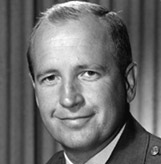
James Martin Taylor was a United States Air Force astronaut and test pilot. Although he trained for the USAF Manned Orbital Laboratory (MOL), the program was cancelled before any of the MOL crews reached space.
